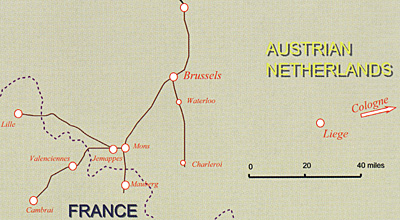Battle of Jemappes
6th November 1792
Declaration of War
by Dave Hollins, UK
| |
Although still a monarchy, France
had formally declared war on Austria on 20th April 1792 and within
a few days, the first attempts to invade the
Austrian Netherlands (now Belgium and Luxembourg)
had begun. A series of small defeats
quickly put an end to this plan and prompted
the National Assembly to call for a new levy
of troops, the Volunteers of 1792, before a
second attempt failed in June.
The Franco-Belgian border -– scene of the opening and closing campaigns
of the 23 years of war. As in 1815, the battles were fought to secure control of the main roads to Brussels.
Having halted
the Prussian advance from the east at Valmy
on 20th September, the French decided to
make a third attempt on the Netherlands in
overwhelming force, confident that the local
people would again rebel against the Austrians
as they had done unsuccessfully during
1788-91. Being still officially the Royal Army,
the French regiments had nevertheless
been numbered and abandoned their old titles
(demi-brigades were created on 21 February
1793 with the first amalgame).
Long an advocate of an invasion, General
Charles Francois Dumouriez was appointed
commander of the Armee du Nord and after
supporting Kellermann at Valmy, he set off to
put his plan into action with about 90,000
men. Duke Albert of Saxe-Teschen, Governor
of the Austrian Netherlands and commander
of the forces there, was forced to abandon his
position at Lille and withdraw on Mons.
His 40,000 troops were spread out in a cordon
along the 100 miles (160km), but he was able
to gather 13,800 men to face the new French
thrust. The French troops were now better
trained and with the confidence of being on
the offensive, marched from Valenciennes
towards Mons on 3rd November, while troops
based around Lille and Mauberge mounted
diversions. There was an initial skirmish at
Bossu that same day, but the Austrians lacked
the forces to establish a defensive position on
the Frameries hills. Duke Albert had sent three
battalions and some squadrons there on 4th
November, but had pulled them back to join
the withdrawing main army that evening.
The way in which Dumouriez had directed the
attack on the Austrian troops seems to have
surprised the Austrian headquarters – Chief of
Staff Oberst Lindenau wrote “His way of advancing
on us was completely new and almost
the same as a siege”.
Battle of Jemappes 6th November 1792
|
 Revolutionary France Seizes Belgium
Revolutionary France Seizes Belgium